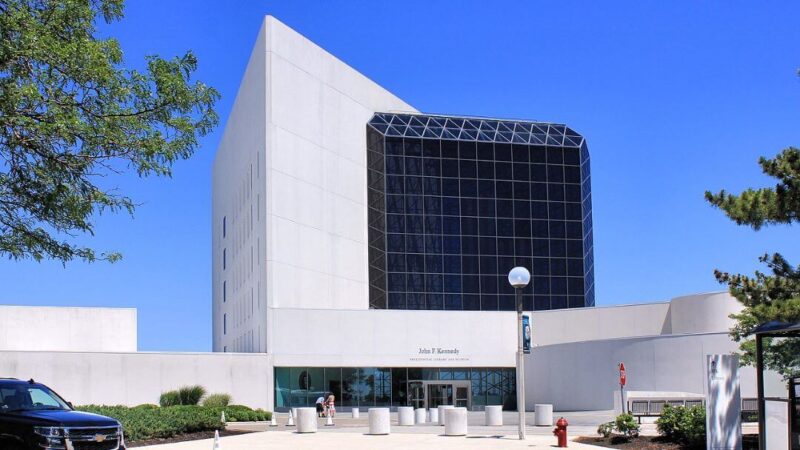In Boston on the shore of the Atlantic Ocean, an imposing modernist monument to the life of President John F. Kennedy stands tall. Architect I. M. Pei called the JFK Presidential Library and Museum “the most important commission in my life.” While Pei himself was frustrated by the project’s setbacks and its final result, most who visit will be impressed with the structure’s soaring lines and thoughtful design.
Planning the JFK Presidential Library and Museum

The original concept for the library was simply to serve as a Presidential Library. President John F. Kennedy was looking into building it in Cambridge, MA. In fact, he was surveying sites with architect John Carl Warnecke, who was a close associate with his family.
Alas, within a month of selecting a site, JFK was assassinated. His family decided to go ahead with the library project, and make it a memorial. Jacqueline Kennedy chose Warnecke to design the John F. Kennedy Eternal Flame, which became his grave site. He also served on the advisory committee for the library project.
Some of the other famous architects who were on the committee included Mies van der Rohe, Paul Thiry and Pietro Belluschi. I. M. Pei was on the committee as well, and ultimately was selected as the architect.
At the time, Pei was actually pretty obscure, so Jacqueline was putting a lot of faith in him. Remarking on the selection, she said, “He was so full of promise, like Jack; they were born in the same year. I decided it would be fun to take a great leap with him.”
Project Delays

If all had gone as planned, the library’s construction would have concluded by 1970. Alas, all did not go as planned. In fact, it took until 1970 to even get the Massachusetts Bay Transit Authority (MBTA) to clear away heavy machinery from the site (which used to be a train yard) so that a soil study could begin.
It wasn’t just the MBTA that was putting up roadblocks to construction either. At the time, the planned site was in Cambridge, and Cambridge residents did not want the library or the influx of tourism it might create. As a result, the team finally chose to move the project to Boston. Budgeting constraints also led to changes in the design and materials for the library. Groundbreaking took place in 1977.
The Final Design of the JFK Presidential Library and Museum

I. M. Pei’s finished design features split levels. Great care was put into not just the placement of different components of the structure in space, but also the way in which visitors would be funneled through the library and museum.

The official website for the museum explains how visitors start out in the exhibition sections, where they learn about JFK’s life and work, and how, “From this darkened setting they emerge into the sun-filled, silent void of the space-framed glass pavilion. Except for an enormous American flag suspended above, the space is empty to allow the viewer to contemplate what he has seen and experienced against a great panorama of sky, land and open sea.”
In short, the John F. Kennedy Library and Museum is visual poetry cast in glass and concrete. The emptiness of the pavilion is not truly empty; it is filled with the thoughts and emotions of visitors as they reflect upon the late president’s life and accomplishments.
That emptiness conveys a sense of the infinite. The exhibits contain objects that capture moments of JFK’s life and contributions. But a life is more than a series of material objects, and the “silent void” stands for that which is boundless and immeasurable.
If you enjoyed this post, check out The Herbert F. Johnson Museum of Art: A Window on the Landscape. Also see This I.M. Pei Designed Hot Spot in NYC was Transformed into a Hospital. And of course, don’t forget to follow us on Instagram, Facebook and Pinterest for more Mid Century Modern inspiration!












